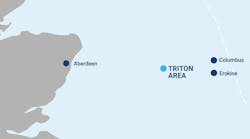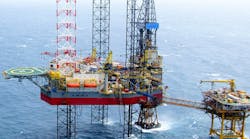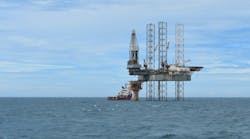Charlie Williams
Center for Offshore Safety
Since the 2010 spill at the Macondo prospect in theGulf of Mexico, the oil and natural gas industry and government regulators have made tremendous strides to enhance the safety of offshore operations. For several years, all oil and natural gas operators on the US outer continental shelf have been required to implement and undergo audits of their required safety programs, known as Safety and Environmental Management Systems (SEMS). The Bureau of Safety and Environmental Enforcement (BSEE) recently made several updates to its SEMS regulations that will likewise impact every offshore operator, including a requirement that SEMS audits be provided by accredited auditors.
As the cornerstone of BSEE’s hybrid regulatory approach, the aim of SEMS is to encourage the offshore oil and natural gas industry to continually advance its safety culture by looking beyond baseline compliance with regulations and toward continuous improvement in safety and environmental performance management. By using SEMS, organizations are better able to influence human behavior, organizational structure, leadership, standards, processes, procedures and operating integrity.
On June 5, compliance with the auditing requirements of BSEE’s SEMS II rule took effect, mandating that all required audits of offshore operators’ SEMS programs be conducted with an independent, accredited, third-party audit service provider (ASP) in the lead. The operator is responsible for providing SEMS audit reports to BSEE, who then holds the operator responsible for addressing any problems that are identified. These third-party audits supplement and complement other BSEE inspection and enforcement activities.
In June, BSEE approved the Center for Offshore Safety (COS) as the first – and currently the only – body authorized to accredit audit service providers for the purpose of conducting SEMS audits of offshore oil and natural gas operators for BSEE. COS’ program has been in operation for several years and has already accredited four ASPs as of July 1. Several others are also under consideration. COS-accreditation provides all operators, not just COS members, assurance that ASPs are capable of providing assessments in conformance with COS’ program requirements. BSEE’s recognition of this COS program means that all COS-accredited auditors meet the new regulatory requirements.
The COS accreditation process involves evaluation of an ASP’s written procedures and programs for planning, executing, and reporting SEMS audits, as well as for assuring the competency and impartiality of their auditors. ASPs and individual auditors must meet certain requirements for skills, knowledge, experience, competency, and impartiality. Such requirements include but are not limited to internationally recognized standards such as ISO/IEC 17021 and ISO 19011, which cover the guidelines an ASP must follow when audit services are provided, as well as those provided by the auditor. COS then audits the ASPs program and performs a “witness assessment” of the ASP’s SEMS audit of an operator. A firm may only receive COS accreditation after demonstrating that its auditing program meets COS requirements.
A SEMS management system audit is an evaluation of the implementation, maintenance, and performance of the SEMS program. It evaluates the effectiveness of the overall system and its elements in delivering expected safety and environmental performance. These audits are performance-based, seek to identify system gaps, and are conducted at predetermined intervals. A system audit report includes conclusions based on observations made by the auditor on the design and implementation of the SEMS system, which include the identified conformities and deficiencies. All conclusions in the report must be supported by objective evidence made by the auditor during the audit, which may include review of records, policies, procedures, and interviews with personnel involved in the management system. The audit report may also identify strengths found within the auditee management system. The audit results drive changes to the audited company’s SEMS and continuous improvement.
The oil and natural gas industry created the Center for Offshore Safety in 2010 in an effort to achieve excellence in safety performance of its offshore operations. Its mission is to “promote the highest level of safety for offshore drilling, completions, and operations through effective leadership, communication, teamwork, utilization of disciplined management systems, and independent third-party auditing and certification.” Third-party auditing, SEMS assistance, and ASP accreditation have been an integral part from the beginning of the COS’ work and mission.
By the end of the first SEMS audit cycle, 86% of regulated operators were able to successfully demonstrate through a formal audit that the required SEMS program was established and operational. An estimated 95% or more of the regulated operators used the COS audit tools and protocols to conduct their audits. COS also requires its operator members to complete a SEMS audit via a third-party ASP accredited by COS. COS contractor members have also begun to conduct voluntary SEMS audits. The Center feels this approach will have significant benefit for both operators and contractors.
Being a COS member means embracing its guiding principles by working together to share learnings about SEMS and safety; to develop good practices based on data to improve performance; and to create a pervasive culture of safety. Its members’ safety and environmental processes, equipment, training, and technology undergo constant examination and improvement, and they share learnings and embrace industry standards and COS good practices to drive continuous improvement. All eligible COS operator members successfully completed the first round of BSEE SEMS audits.
Contractors, although not subject to the third-party audit requirements under the SEMS II rule, may elect to voluntarily conduct SEMS audits. SEMS auditing by contractors is another clear indication of their commitment to safety and effectiveness of their safety management. The process makes it easier to align, plan, and execute safety management as the contractors and operators work together. It also allows contractors to be more effective, focused, and efficient in managing their SEMS program.
Operators and regulators gain the additional assurance that the contractor meets all the SEMS elements and requirements that an operator must meet and their programs are well aligned. This voluntary SEMS auditing of contractors can assist in reducing the redundant assessments by multiple operators on the contractors by providing a single, well planned, and executed SEMS audit by an accredited ASP. This will allow more time and focus on bridging agreements – improving communication and relationships between operators and contractors – and more time and resources on managing safety. At the time of this publication, two contractors, Pacific Drilling and Schlumberger, have successfully conducted SEMS audits through accredited auditors.
By aligning their programs with the new SEMS, operators and contractors alike can further the industry-wide goal of achieving greater safety offshore. COS looks forward to being an accreditation body and continuing to work with BSEE and all companies involved in the offshore oil and natural gas industry as it pursues more effective safety and environmental protection through SEMS and SEMS auditing. •
The author
Charles (Charlie) R. Williams II was named executive director for the Center for Offshore Safety in March 2012. Previously, he retired from Shell Oil as Chief Scientist–Well Engineering after a 40-year career.






